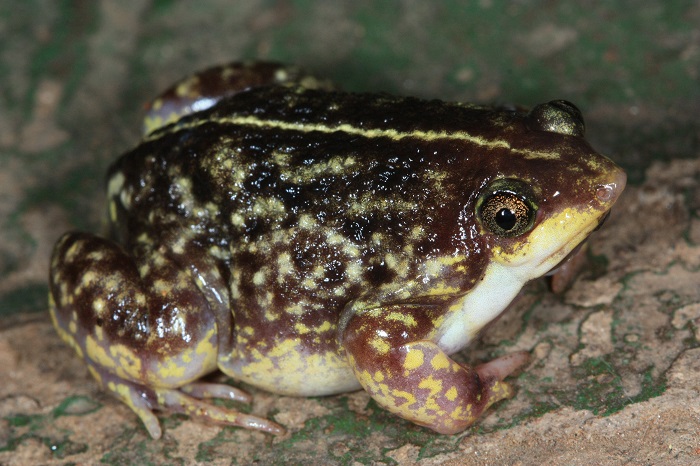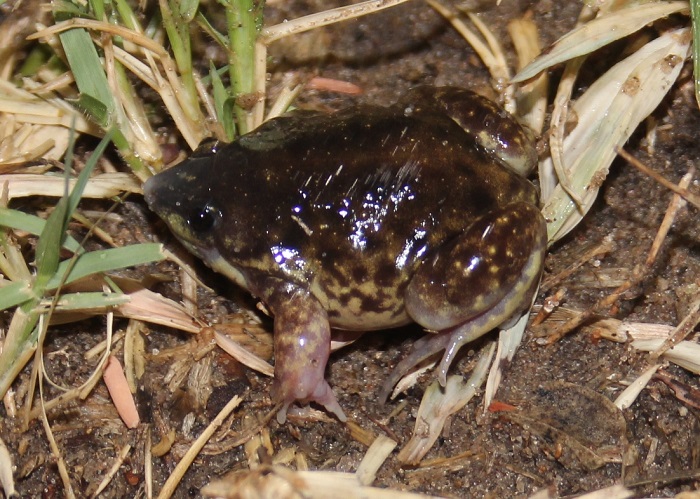View the above photo record (by Cornelia Rautenbach) in FrogMAP here.
Find the Guinea Shovel-nosed Frog in the FBIS database (Freshwater Biodiversity Information System) here.
Family Hemisotidae
GUINEA SHOVEL-NOSED FROG – Hemisus guineensis
Cope, 1865
Habitat
Channing (2001: 122) recorded the habitat of H. guineensis as “grassland and open bush where temporary pans are formed in the rainy season”. The recorded localities for H. g. broadleyi in Limpopo Province are situated in Mopane Bushveld in the Savanna Biome.
Behaviour
Little is known of the biology of this frog. Its breeding behaviour is probably similar to that of the other species in the genus.

Photo by Dawn Toussaint
Status and Conservation
In the atlas region, H. guineensis has a peripheral distribution. Although it is not known to occur in any protected areas, the areas from which it has been recorded do not appear to be seriously threatened by habitat loss or degradation.
Distribution
H. guineensis broadleyi, a subspecies of the West African H. guineensis, is distributed through Angola, northern Botswana, Zimbabwe, Zambia and Mozambique.
Museum specimens collected at two localities in Limpopo Province: the farms Bridgewater (263MS; 2229CA), 25 km northeast of Alldays, and Rochdale (700MS; 2229DC), 8 km east of Waterpoort, have been assigned to this species (Poynton and Broadley 1985a; Jacobsen 1989). However, Poynton and Broadley (1985a) experienced difficulty in separating some specimens of H. g. broadleyi from H. marmoratus, using the morphological criteria identified by Laurent (1972). They suggested that in this area a complex situation exists, involving intergradation between the two taxa, and noted that the problem could only be resolved by the collection of field data and a larger series of specimens.
Similarly, Channing and Griffin (1993) reported an extreme range of morphological variation in a sample of 50 Hemisus specimens collected in the Caprivi, on the basis of which some individuals could be assigned to H. marmoratus and others to H. guineensis microps. However, only one call type was heard during three months of field work, and they concluded that only H. marmoratus was present in the Caprivi.
Channing’s (2001) description of the advertisement calls of H. marmoratus and H. g. broadleyi indicates a difference of 1000 Hz in emphasized frequency, while the pulse rate of H. g. broadleyi is approximately half that of H. marmoratus. When this part of Limpopo Province was surveyed during the atlas period, no calls were heard that could be attributed to H. g. broadleyi or to intergrades. H. marmoratus was heard calling at a number of localities in Limpopo Province, but the calls did not differ from those of H. marmoratus from other parts of the atlas region (pers. obs).
Thus it seems that H. g. broadleyi, if present at all, must occur in very low numbers in the atlas region. This is an open question that invites further investigation in the form of more intensive surveys in the area between the Soutpansberg Mountains and the Limpopo River.
No map is currently available for this species.
Further Resources
Virtual Museum (FrogMAP > Search VM > By Scientific or Common Name)
More common names: Guinea Snout-burrower (Alternative English Name); Guinease Graafneuspadda (Afrikaans)
Recommended citation format for this species text:
Minter LR, Tippett RM. Guinea Shovel-nosed Frog Hemisus guineensis. BDI, Cape Town.
Available online at http://thebdi.org/2022/01/23/guinea-shovel-nosed-frog-hemisus-guineensis/
Recommended citation format:
This species text has been updated and expanded from the text in the
2004 frog atlas. The reference to the text and the book are as follows:
Minter LR 2004 Hemisus guineensis Guinea Shovel-nosed Frog. In Minter LR
et al 2004.
Minter LR, Burger M, Harrison JA, Braack HH, Bishop PJ, Kloepfer D (eds)
2004. Atlas and Red Data Book of the Frogs of South Africa, Lesotho and
Swaziland. Smithsonian Institution, Washington, and Avian Demography
Unit, Cape Town.

